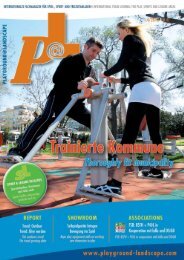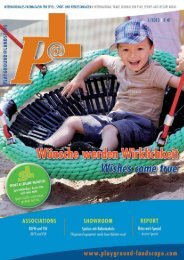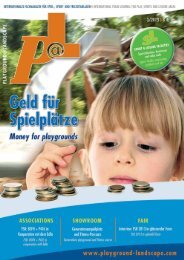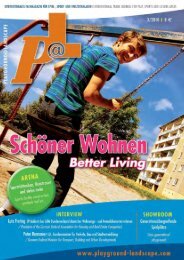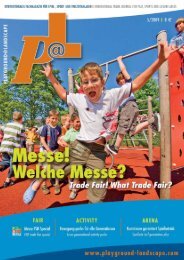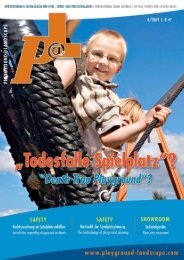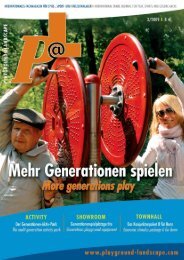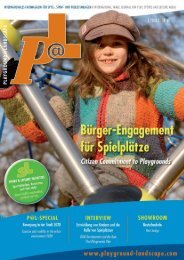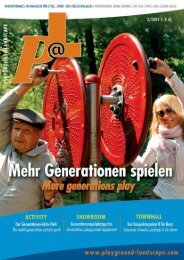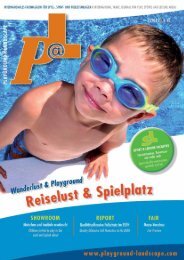Download - Playground@Landscape
Download - Playground@Landscape
Download - Playground@Landscape
Sie wollen auch ein ePaper? Erhöhen Sie die Reichweite Ihrer Titel.
YUMPU macht aus Druck-PDFs automatisch weboptimierte ePaper, die Google liebt.
ACTIVITY<br />
spend in physical activities. Toddlers require physical play in<br />
order to develop fundamental capabilities for their later learning.<br />
They learn and develop their abilities in play.<br />
Toddlers’ physical proportions: Whenever politicians and parents<br />
work on a more efficient nursery concept, it is often forgotten how<br />
small toddlers are.<br />
In considering toddler development, adults ought to take absolutely<br />
literally the phrase, “from the child's perspective”.<br />
Getting down on our knees, in order to see the world from their<br />
eye-level, is a good start if we are to understand dimensions and<br />
proportions from the toddler's point of view. A two-year old child<br />
is on average 90 cm in height. The proportions of the toddler's<br />
body are different from those of an adult’s body; toddlers have a<br />
larger head and shorter arms and legs in proportion to the body.<br />
This makes balance difficult. Play areas for toddlers should<br />
generally take into account the ergonomics and development of<br />
toddlers.<br />
The sense of balance: The sense of balance should be exercised by<br />
toddlers, since their physical proportions make it correspondingly<br />
more difficult to keep their balance. The sense of balance is trained<br />
by physical activity, e.g. by gentle rocking, swinging or turning.<br />
Lying on the stomach and rocking backwards and forwards is an<br />
attractive activity, for toddlers have not yet developed the ability<br />
to rock properly and on their own. The rhythm of this movement<br />
encourages the basis for language. It has often been observed how<br />
children sing in tune whenever they are rocking forward and back.<br />
Sense of space: Toddlers' spatial awareness has not yet fully developed.<br />
All the words which describe space must be assimilated.<br />
Whenever toddlers fail to experience what it means to be above or<br />
below, to clamber over or under something, to sit higher or lower,<br />
they miss out on basic understanding of dimensions and space,<br />
and therefore later they also miss out on Mathematics. Spatial<br />
awareness has to be appropriately trained and challenged.<br />
Visual and tactile awareness: Because of the delayed reaction time<br />
of the nerves in toddlers, they need longer to grasp their physical<br />
surroundings. Mastering steps, stairs etc. often takes up their entire<br />
concentration. A toddler's sense of touch is not at the level of that<br />
of a normal adult. Hand-eye coordination, seeing something and<br />
wanting to grasp it in the hand and the sense of touch have to be<br />
stimulated, supported and trained.<br />
Germination of friendships: Scientific studies have shown that<br />
toddlers cultivate social interaction, although they still have a very<br />
limited repertoire of language. They invent repetition games and<br />
play these in groups, imitating the behaviour and noises of the others.<br />
Spring riders, small rockers or – to make eye-contact possible –<br />
tummy swings arranged in pairs and more generally playing in<br />
groups of two or three are beneficial, as is themed role play, which<br />
also facilitates physical activity.<br />
Innate play instinct: Fortunately toddlers need little encouragement<br />
to grasp the idea of play situations, which stimulate and<br />
train the physical challenges described above. In order to guarantee<br />
that activities for toddlers remain linked to pleasure, adults<br />
should not exert pressure on children to improve their skills, but<br />
should be happy to encourage and support them.<br />
Toddlers' play equipment for child development: The provision of<br />
suitable opportunities for play is an important contribution to<br />
countering the changes in everyday routine and reacting to the<br />
needs of toddlers. For instance, toddler-sized playground<br />
equipment is to be recommended for the development of language,<br />
creativity and motor skills. Such equipment should be calibrated<br />
to the needs of toddlers and their carers in day centres, in order to<br />
take account both of the stages in child development and of the<br />
educational objectives of the respective federal state.<br />
Appropriate play equipment is ideal for play, fun and learning in<br />
the fresh air – both for toddlers and for adults.<br />
Photos: Kompan<br />
SPIELIDEEN DIE ÜBERZEUGEN<br />
OBRA-Design, Ing. Philipp GmbH & Co.KG<br />
Satteltal 2, A-4872 Neukirchen/Vöckla<br />
Tel.: +43 (0)7682/2162-0<br />
E-Mail: obra@obra.at, www.obra.at<br />
63



